Automated Broadcast with Graphics Overlay
Reading time ~11 minutes
This article describes how to get your Cinegy software up and running for automatic broadcasting with overlay graphics. Working with graphics requires additional use of the Cinegy Title Editor in addition to the basic Cinegy Air software.
Through the course of this quick guide the following steps will be required to be completed:
Prerequisites
Make sure the machine you are using has the required Microsoft Windows operating system installed along with the latest service packs. Cinegy Air system recommendations are available here.
Check that any sets of custom codecs or fonts are installed on both the client and the playout server stations.
Make sure that you have at least local administrator rights required to install and configure applications on your computer.
Download the latest Cinegy Air and Cinegy Title installation packages from either the Cinegy Partner portal or the Cinegy Customer portal, or visit the official Cinegy website to download a trial version of Cinegy Air, which you can evaluate free of charge.
Make sure the Cinegy Air license is applied as per instructions sent along the Cinegy product evaluation e-mail or directly from your sales manager.
Installation
For this scenario Cinegy Air, Cinegy Playout and Cinegy Title are required. All these applications should be installed on the same computer.
Cinegy Air PRO Installation
|
Important
|
This paragraph contains a quick installation guide. For complete description of Cinegy Air installation, please refer to the Cinegy Air Manual. |
Follow these steps to install the Cinegy Air PRO control application:
-
Run the Setup.exe file from the "Cinegy Air PRO" folder of your Cinegy Air installation package. The setup wizard appears. Press "Next" to proceed with the Cinegy Air PRO installation.
-
Read and accept the license agreement and proceed with installation.
-
Press the "Browse" button to select the installation folder and press "Next" to proceed.
-
Select the features to be installed - only the Air PRO component is obligatory. Press "Next" to proceed.
-
Press the "Install" button to begin the installation. The wizard will inform you that the installation is complete. Press the "Finish" button to exit the setup wizard.
|
After installation, you will find the Cinegy Air PRO icon on your Windows desktop. |
Cinegy Playout Installation
|
Important
|
This paragraph contains a quick installation guide. For complete description of Cinegy Playout installation, please refer to the Cinegy Playout Manual. |
-
Run the Setup.exe file from the "Cinegy Playout" directory of your Cinegy Air installation package. The setup wizard appears. Press "Next" to proceed with the installation.
-
Read and accept the license agreement and proceed with installation.
-
Define the folder where Cinegy Playout will be installed.
-
Press the "Install" button to begin the installation. The wizard will inform you that the installation is complete. Press the "Finish" button to exit the setup wizard.
-
A message will inform you that the computer restart is required. Press "Yes" for the Cinegy Playout installation to be completed.
|
After restart, the Cinegy Playout Dashboard icon will appear in the notification area of the taskbar. |
Cinegy Title Installation
|
Important
|
This paragraph contains a quick installation guide. For complete description of Cinegy Title installation, please refer to the Cinegy Title Manual. |
Follow these steps to install the Cinegy Title Editor:
-
Run the Setup.exe file from your Cinegy Title installation package. The setup wizard is started. Press "Next" to proceed with the Cinegy Title installation.
-
Read and accept the license agreement and proceed with installation.
-
Define the folder where Cinegy Title will be installed and press "Next" to proceed.
-
Press the "Install" button to begin the installation. The wizard will inform you that the installation is complete. Press the "Finish" button to exit the setup wizard.
|
After installation, the Cinegy Title icon will appear on your Windows desktop. |
Configuration
Cinegy Air PRO Configuration
|
Important
|
This paragraph contains a quick configuration guide. For complete description of Cinegy Air configuration, please refer to the Cinegy Air Manual. |
To start the Cinegy Air PRO configuration tool, go to Start > Cinegy > Cinegy Air PRO Config:
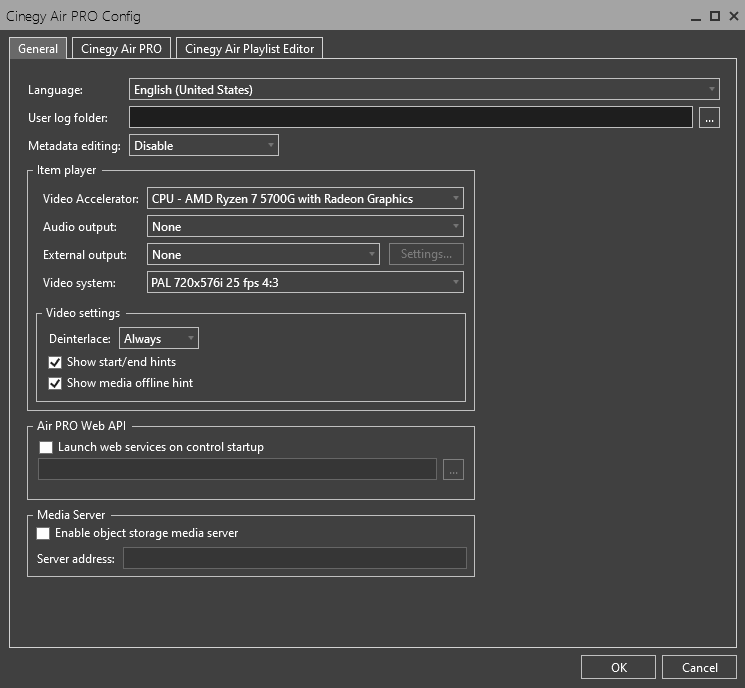
-
Switch to the "Cinegy Air PRO" tab.
-
Click the empty line underneath the list of channels and type in a channel name to add a new channel for broadcasting.
NoteFor a product demo, it is sufficient to set up just one channel. -
From the "Video system" drop-down list choose the TV format for this channel and define the aspect ratio for the video stream.
-
For "Engine 1", select the "Local" checkbox meaning that Cinegy Playout is installed and launched on the local computer. Leave the "0" value in the "#" field meaning that the instance # 0 will be used for this channel playout.
-
In the "Active playlist" field press the
 button to choose the location and define the name for the active playlist.
button to choose the location and define the name for the active playlist. -
In the "CG Repository" press the
 button to define the location for Cinegy Title templates, which will be created later while following this quick guide.
button to define the location for Cinegy Title templates, which will be created later while following this quick guide. -
After completing all the steps, click "OK".
Cinegy Playout Configuration
|
Important
|
This paragraph contains a quick configuration guide. For complete description of Cinegy Playout configuration, please refer to the Cinegy Playout Manual. |
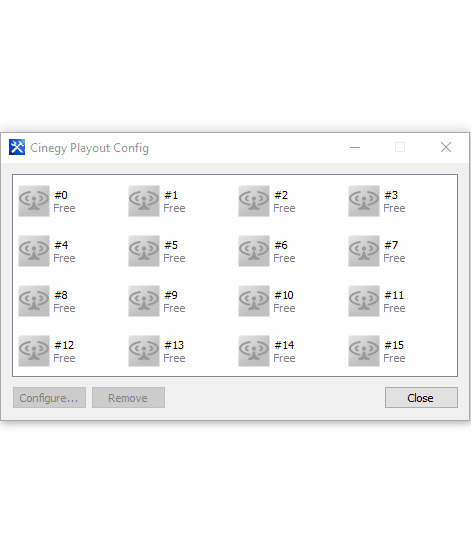
-
To start the Cinegy Playout configuration tool, go to Start > Cinegy > Cinegy Playout Config. It can also be accessed by right-clicking the icon in the taskbar and using the "Open configuration utility" command. By default, no instances are configured and they are all marked as "Free". Select the instance #0 (this instance number was defined during Cinegy Air channel configuration) and press the "Configure…" button. The configuration dialog of that particular instance will appear.
-
Optionally, in the "General" tab, specify the instance name.
-
In the "Licensing" tab select the "Cinegy Air PRO" connection to allow the Cinegy Air PRO client to connect to the corresponding Cinegy Playout engine. The "License usage summary" grid shows the amount and types of required licenses. Make sure all these licenses are available; otherwise, the Cinegy Playout instance will not run at all.
-
In the "Playback" tab, in the "Player mode" drop-down list choose the same TV format as defined for the Cinegy Air playlist in the previous section.
CautionThe video system frame rate should match the frame rate of the content to be used in the playlist. -
To show output on screen for testing purposes, define "Screen Output" as the output device.
NoteFor information about the input and output devices configuration, refer to this article. -
In the "Video effect accelerator" drop-down list choose the video board available on your computer.
-
In the "CG" tab select the corresponding option in the "CG and Channel Branding option" group to be able to send Cinegy Title scenes to playout.
-
Optionally, in the "Logging" tab, define the log files creation settings that will simplify the support procedure and help the user in troubleshooting potential issues that may occur.
Creating Cinegy Title Template
In Cinegy Title you can create multiple layers of automation controlled, template-based titles, logos, animated graphics, and more. In this quick guide we will start with creating a simple template with scrolling text.

To create a simple Cinegy Title template with the scrolling text, follow the steps:
-
Launch Cinegy Title, Cinegy Title Editor will be open.
-
Create a new template by using the "New" command from the "File" main menu or the Ctrl+N shortcut.
-
Specify the Cinegy Title template name in the "Title name" field and choose the TV format used in Cinegy Air playlist. Press "OK" to apply changes.
-
To create a simple scrolling text, choose the Marquee object on the elements panel.
-
In the "Marquee" tab enter the text to be displayed.
-
To preview the scrolling text on the canvas, press the "Play" button on the lower part of the canvas panel.
-
Having finished editing your template, save it by using the "Save" command from the "File" main menu or Ctrl+S shortcut. In the "Save As" dialog navigate to the location defined as CG repository during Cinegy Air channel configuration and press "Save".
|
Important
|
For a detailed description of creating and editing Cinegy Title templates, creating multi-layered titles and animations, please refer to the Cinegy Title Manual. |
Launching Cinegy Playout
Cinegy Playout is responsible for the playlist items playback. By default, Cinegy Playout is loaded automatically on system startup and restarts automatically in case of failure.
When Cinegy Playout is started, the corresponding icon is displayed in the notification area of the taskbar. To see and control the status of all instances, right-click the icon in the taskbar and select the "Show Dashboard" command:
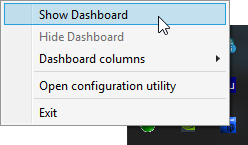
The following Cinegy Playout Dashboard window will appear:

Here you can see the control monitors of all configured Cinegy Playout instances. In this demo guide we have set up one Cinegy Playout instance #0.
|
Press the "Start" button to start the instance broadcasting. |
Each instance can be started/stopped individually.
As "Screen output" was defined as an output device, the window with a blue frame will be opened after the Cinegy Playout instance is started. It will display video frames as soon as a media file is sent on air via Cinegy Air control application (this will be described in the next step).
|
Note
|
If you are using trial license, the "Cinegy Demo Version" sign will be imprinted in the center of the frame. |
Cinegy Air Broadcast Control
Start the Cinegy Air control application and establish connection to Cinegy Playout by activating the ON/OFF bar and pressing the "CONN" button.

If the connection is successful, all Cinegy Air functions are activated.
To fill in the playlist with the content in Cinegy Air supported formats, simply drag-and-drop the media file(s) from the Windows explorer.
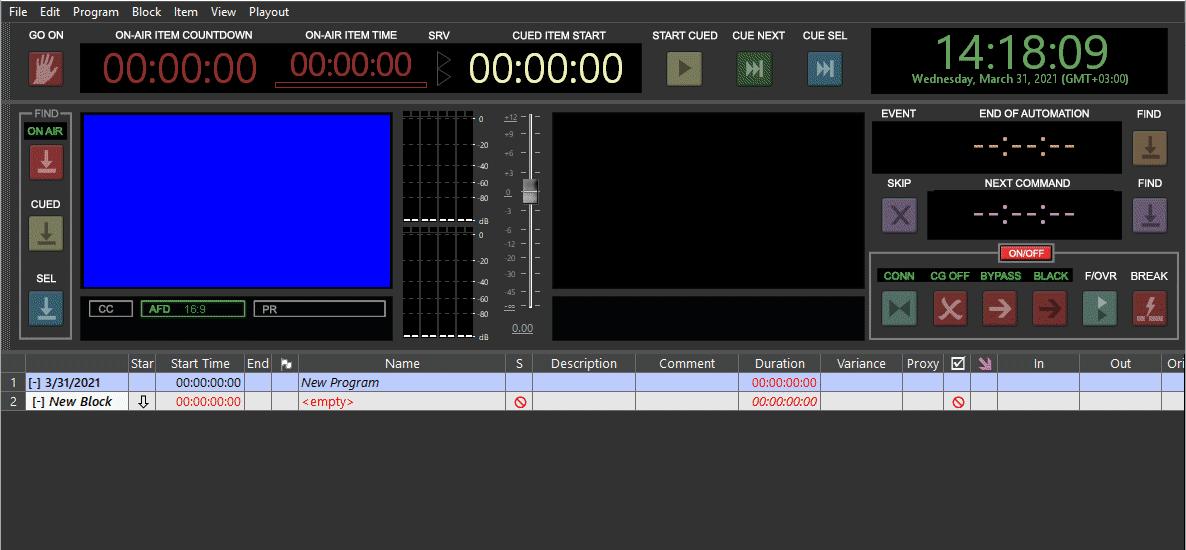
You can also add items to the playlist via the "Insert" > "Item(s)…" context menu command.
Another way to add item to the playlist is using the integrated browser. The File Browser allows the user to browse for video clips stored on the local computer or on a shared network location.
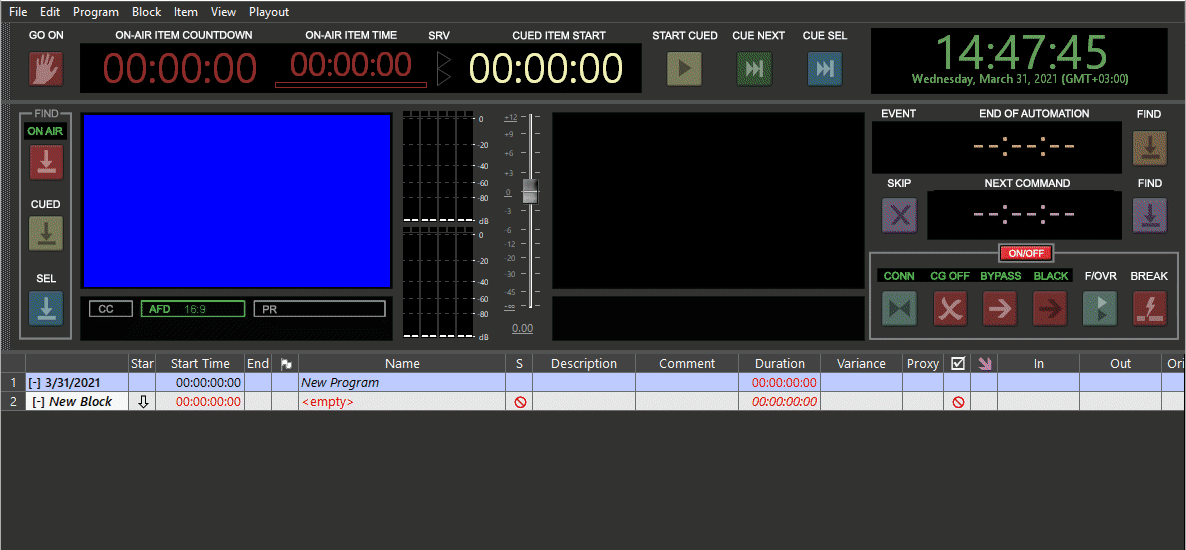
|
Note
|
Please mind that adding the items to the playlist is possible if the items TV format is compatible with the video system defined via the Cinegy Air Configurator. |
Adding Cinegy Title Template
Displaying of the previously created Cinegy Title template can be added as a secondary event for a playlist item.
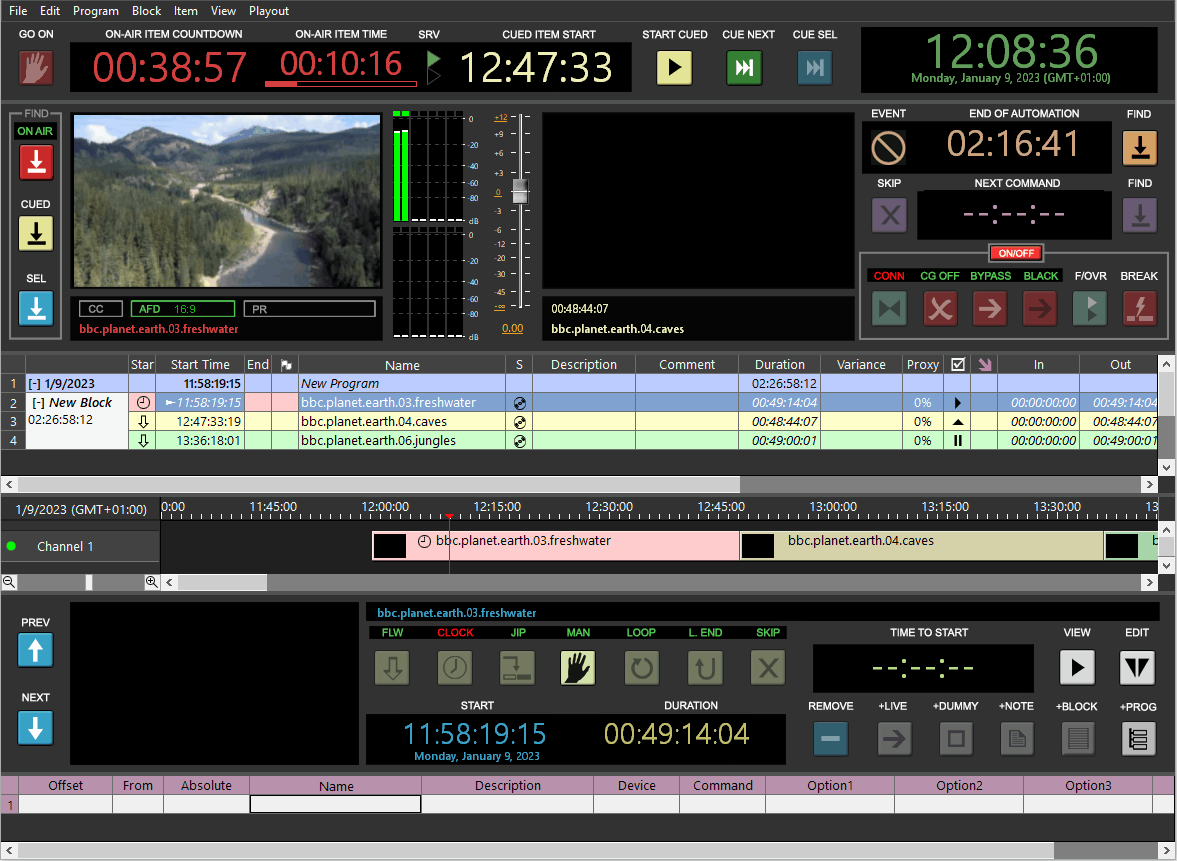
To add the Cinegy Title template as a secondary event, follow the steps:
-
Select the playlist item the secondary event will be added to.
-
In the secondary events panel click the right mouse button to display the secondary events commands context menu.
-
Use "Cinegy Title" > "Show" > "Layer 0" command.
-
The "CG Browser" window will be open. In the "Repository" field select the previously created Cinegy Title template and press "OK" to apply it.
-
The Cinegy Title template will be displayed as soon as the playlist item with the configured secondary event will be sent on air.
-
To stop displaying the Cinegy Title template after the defined amount of time, Use "Cinegy Title" > "Hide" > "Layer 0" command. In the "Offset" field define the time offset from the item start or end (specified in the "From" field) after which the Cinegy Title template will stop being displayed.
|
Important
|
Refer to the Cinegy Title section of the Secondary Events article for a detailed description of adding Cinegy Title templates as secondary events. |
Adding Logotype
Cinegy Air allows adding a logotype display to a playlist item as a secondary event.
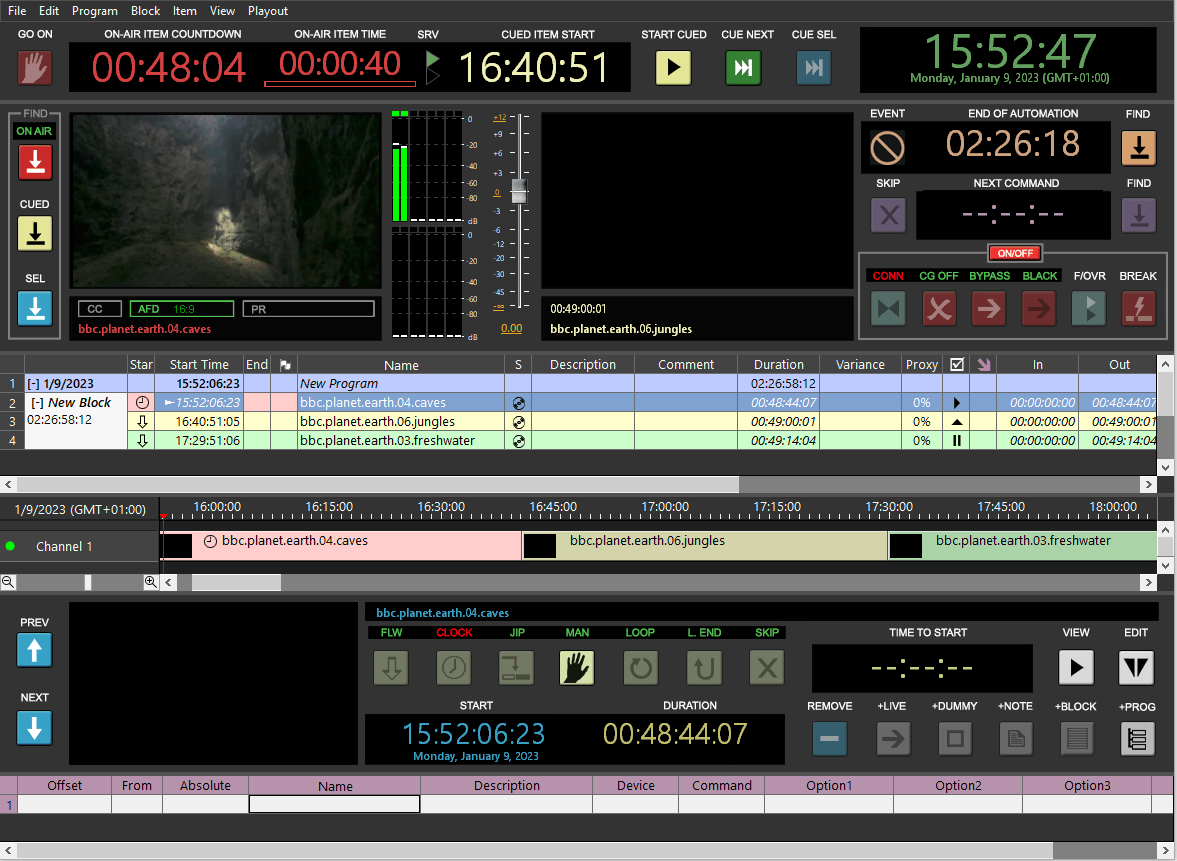
The secondary events panel is located at the bottom of the application and has a table view.
To add a logotype, follow the steps:
-
In the playlist grid, select the item for which logotype displaying will be applied and click the right mouse button in the secondary events panel to display the secondary events commands context menu.
-
To add a logotype, select "Basic Overlay" > "Show…" > "Layer 0" command. The "Cinegy Basic Overlay Editor" dialog appears allowing to define a logo image for the corresponding channel format. For this click in the "File" field of the TV format corresponding to the Cinegy Playout engine channel TV format, press the "…" button and navigate to the logo file on your computer. Press "Open" to select the graphics file. Then press "OK" to close the "Cinegy Basic Overlay Editor" and apply the changes.
-
The logo will be displayed as soon as the playlist item with the configured secondary event will be sent on air. The logo will be applied to all subsequent playlist items until "Basic Overlay" > "Hide" > "Layer 0" command is applied as a secondary event to the playlist item.
|
Important
|
Refer to the Logotype Management section for a detailed description of adding logos as basic overlays. |

